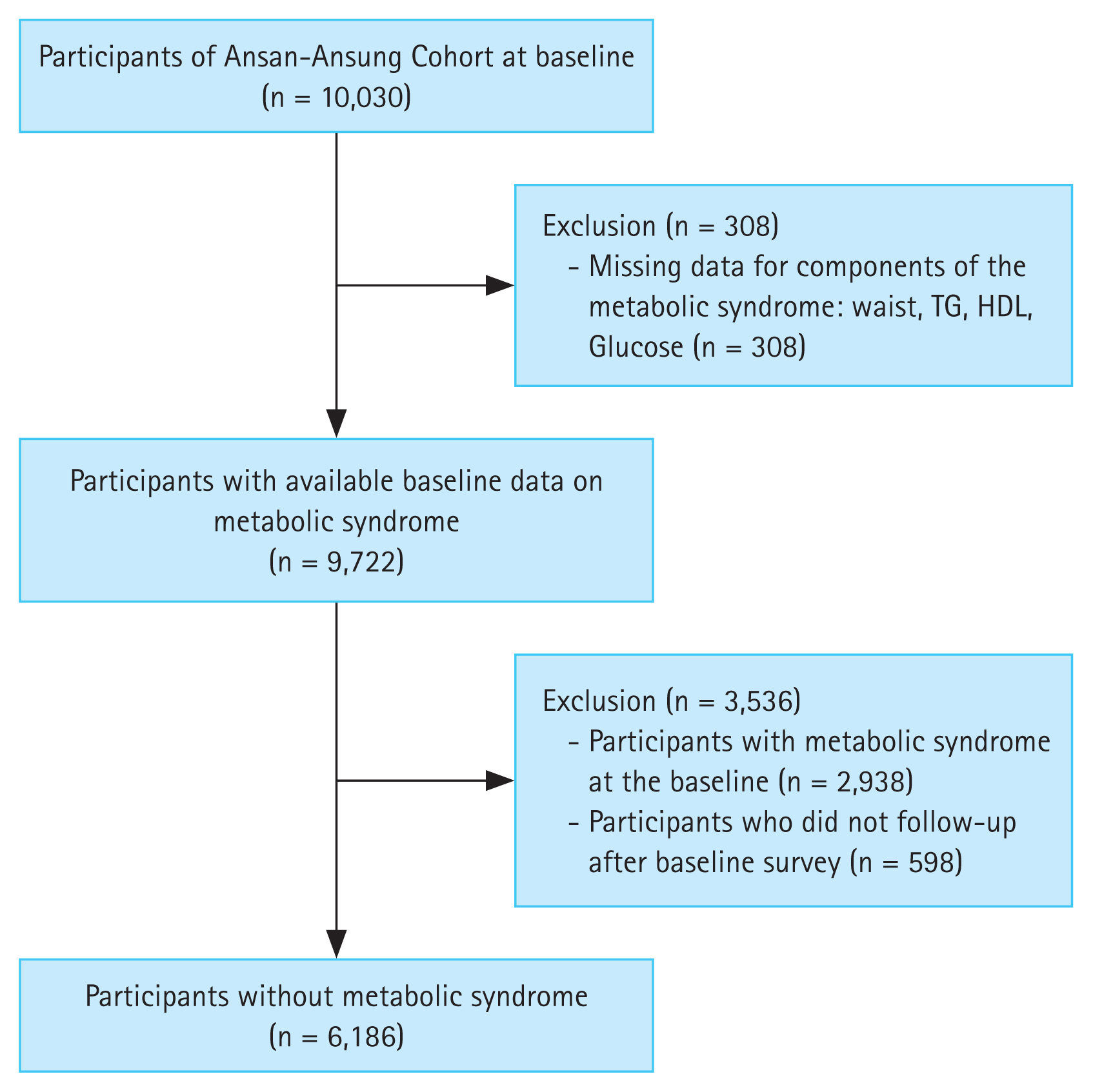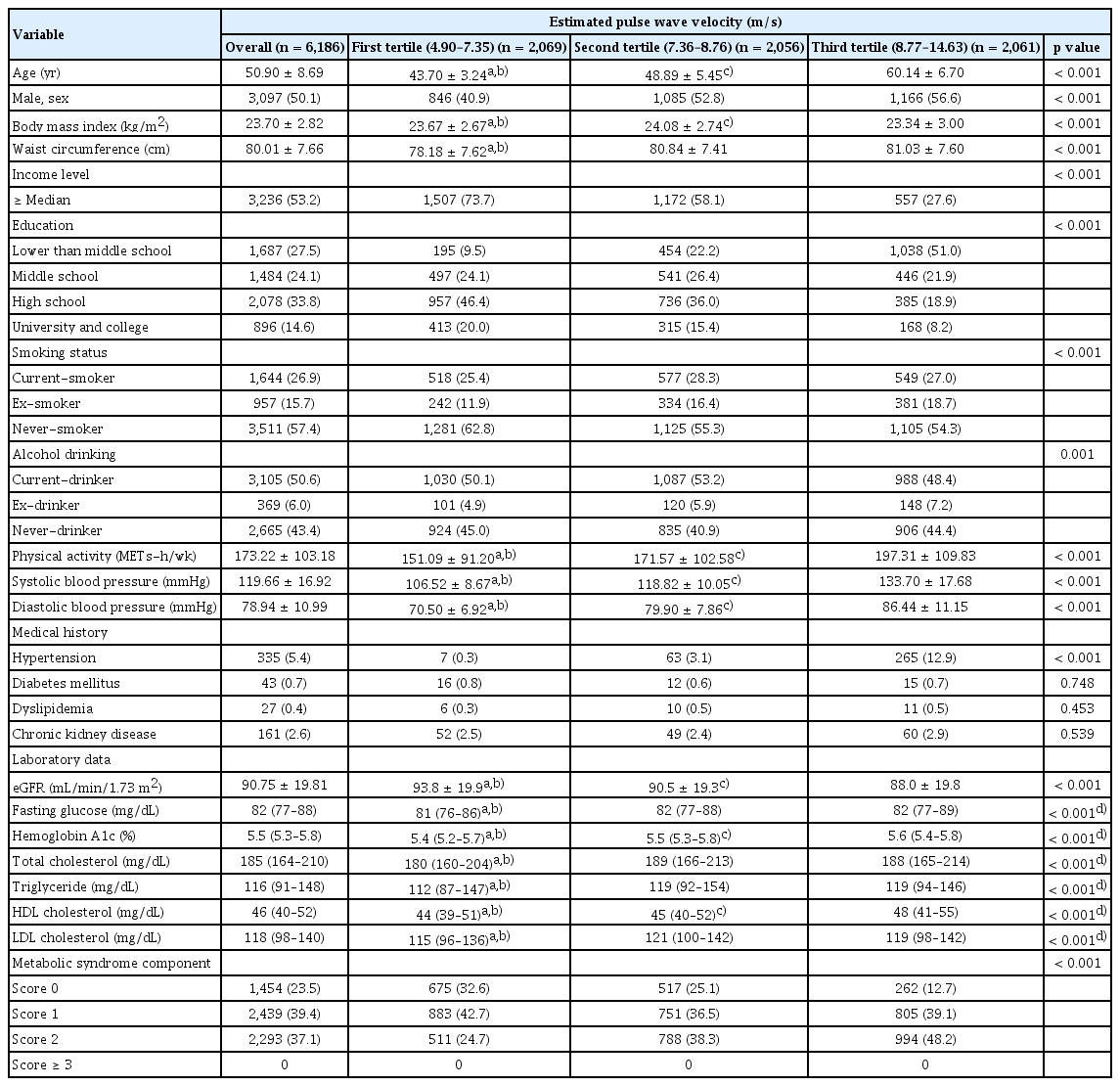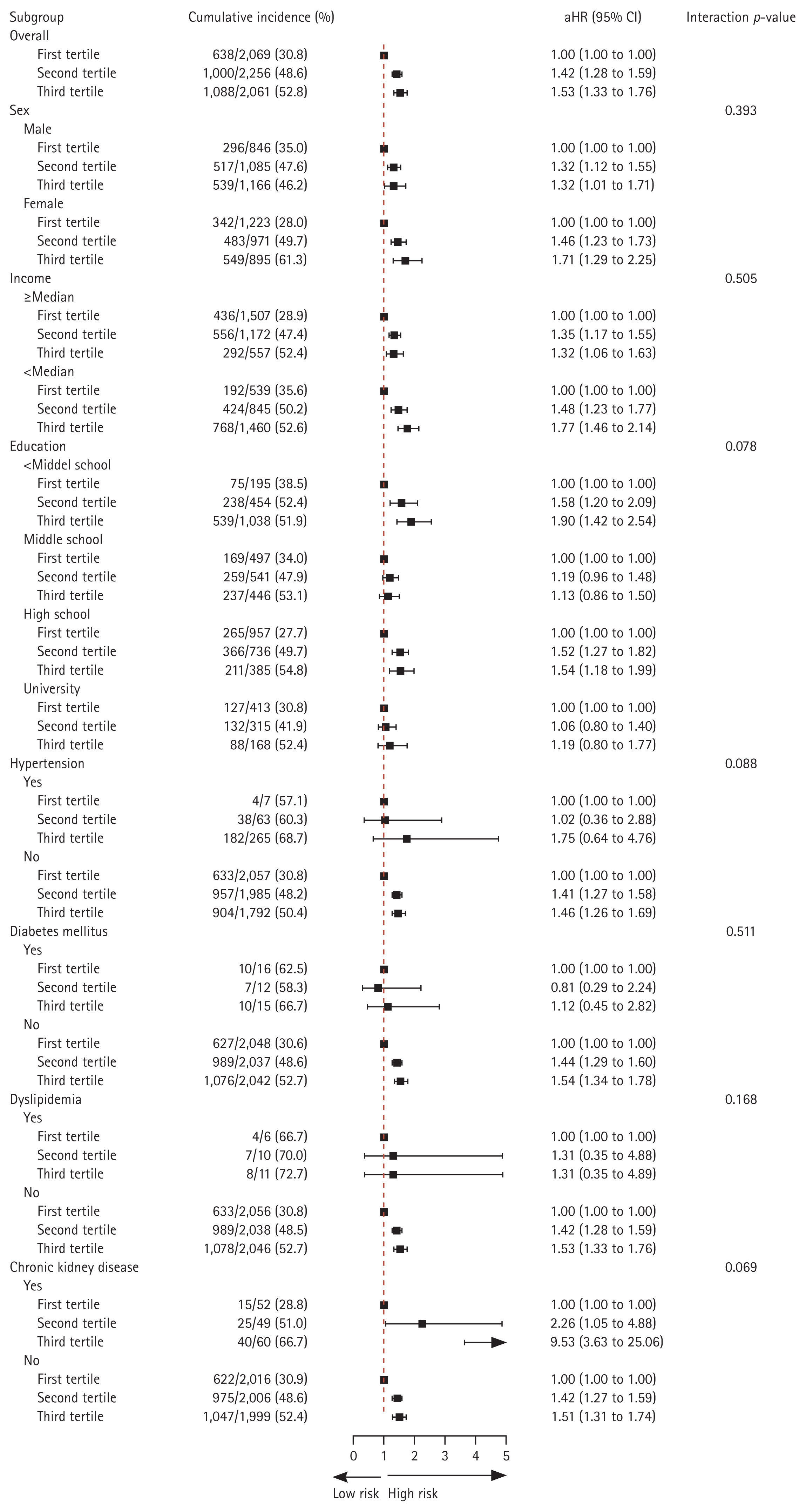Estimated pulse wave velocity as a forefront indicator of developing metabolic syndrome in Korean adults
Article information
Abstract
Background/Aims
The predictive value of the estimated pulse wave velocity (ePWV) for the development of metabolic syndrome has not yet been extensively explored. This study aimed to fill this gap by evaluating ePWV as a potential predictor of metabolic syndrome development in middle-aged Korean adults.
Methods
Using prospective data obtained from the Ansan-Ansung cohort database, participants without metabolic syndrome at baseline were studied. ePWV was calculated using specific equations based on age and blood pressure. The primary outcome was the incidence of metabolic syndrome during a median follow-up period of 187 months.
Results
Among the 6,186 participants, 2,726 (44.1%) developed metabolic syndrome during the follow-up period. ePWV were categorized into tertiles to assess their predictive value for the development of metabolic syndrome. An ePWV cut-off of 7.407 m/s was identified as a predictor of metabolic syndrome development, with a sensitivity of 0.743 and a specificity of 0.464. Participants exceeding this cut-off, especially those in the third tertile (8.77–14.63 m/s), had a notably higher risk of developing metabolic syndrome. Specifically, the third tertile exhibited a 52.8% cumulative incidence compared with 30.8% in the first tertile. After adjustments, those in the third tertile faced a 1.530-fold increased risk of metabolic syndrome (95% confidence interval, 1.330–1.761).
Conclusions
ePWV is a significant predictor of the development of metabolic syndrome. This finding underscores the potential of ePWV as a cardiometabolic risk assessment tool and can thus provide useful information for primary prevention strategies.
INTRODUCTION
Metabolic syndrome is a cluster of conditions that occur together to increase the risk of heart disease, stroke, and type 2 diabetes [1,2]. These conditions include increased blood pressure (BP), high blood sugar levels, excess body fat around the waist, and abnormal cholesterol or triglyceride levels [3,4]. The global increase in the prevalence of metabolic syndrome presents significant challenges for public health systems [5,6]. The early identification and management of at-risk individuals is important to prevent the progression of metabolic syndrome and its associated complications.
Endothelial dysfunction and arterial stiffness are predictors of early cardiovascular diseases [7,8]. Pulse wave velocity (PWV) is a widely accepted noninvasive measure of arterial stiffness and has been shown to be a strong predictor of cardiovascular events and mortality in various populations. An elevated PWV indicates increased arterial stiffness, which is associated with a higher risk of cardiovascular disease [9–11]. Directly measured PWV, such as the carotid-femoral PWV, accurately assesses arterial stiffness. However, owing to practical challenges in its measurement, the estimated PWV (ePWV) has been developed as an alternative. ePWV can be calculated using easily obtainable clinical parameters, including age and BP, offering a more accessible and approximate measure of arterial stiffness [12]. Recent studies have suggested a potential association between increased PWV and the presence of metabolic syndrome components [13–17]. However, the relationship between PWV, specifically ePWV, and metabolic syndrome has not yet been extensively studied.
In clinical settings, a straightforward tool for predicting the future onset of metabolic syndrome in individuals who are currently deemed low risk would be invaluable. This tool could facilitate timely intervention and prevent the onset of the syndrome and its complications. To address this need, our study aimed to evaluate the association between ePWV and metabolic syndrome and determine the predictive value of ePWV for the future onset of metabolic syndrome in the Korean adult population. Moreover, the long-term follow-up of our cohort, extended to 18 years, offers a comprehensive longitudinal perspective, allowing us to monitor the progression of metabolic syndrome in relation to arterial stiffness over an extended period. This approach allows for a more in-depth understanding of early markers and potential intervention points, especially in populations that might not be at high risk for metabolic syndrome.
METHODS
Study population
The Ansan-Ansung cohort formed the basis of this study’s dataset, which encompassed a prospective group of 10,030 individuals. From June 2001 to January 2003, the participants, aged 40–69 years, resided in two Korean cities and provided follow-up information spanning up to 18 years. This group was integrated into the Korean Genome Epidemiology Study, which aimed to understand the genetic and environmental origins of common metabolic and cardiovascular conditions, and was supported by the Korean National Research Institute of Health, Korean Centers for Disease Control and Prevention, and the Ministry of Health and Welfare. A previous publication outlined the detailed methodologies, including comprehensive health checkups, face-to-face interviews, and laboratory testing at each survey site visit. To ensure uniform data collection and consistency, the cohort protocol mandated structured biennial health assessments for all participants, resulting in nine consistent evaluations per participant from baseline to 2018 [18].
In the initial group of 10,030 participants, 9,722 had detailed baseline data covering indicators of metabolic syndrome, such as waist circumference, triglyceride levels, high-density lipoprotein (HDL) cholesterol, fasting serum glucose concentration, and BP readings. Additionally, if the participants received specific treatments for any of these components, the information was documented. Among the participants with complete data, 6,186 were identified as having no metabolic syndrome at baseline (Fig. 1).
Data collection
At each biennial follow-up visit, participants underwent comprehensive health checkups, including consistent measurements of metabolic syndrome components. This consistent approach to data collection at each follow-up visit provided a robust dataset for analyzing the development of metabolic syndrome over time. The dataset also included a range of demographic and clinical characteristics of the participants, including age, sex, body mass index (BMI), waist circumference, systolic blood pressure (SBP) diastolic blood pressure (DBP), income and education levels, smoking habits, alcohol consumption patterns, frequency of physical activity, and any documented medical history indicating traditional cardiovascular risks. Additionally, the collection underscores key laboratory results pertinent to metabolic syndrome, featuring metrics such as estimated glomerular filtration rate (eGFR), fasting glucose concentration, hemoglobin A1C, total cholesterol count, triglycerides, HDL cholesterol, and low-density lipoprotein cholesterol levels.
The evaluation of metabolic syndrome components was based on guidelines adapted from the National Cholesterol Education Program Adult Treatment Panel III (NCEP ATP-III) [4]. The criteria were as follows: (1) abdominal obesity characterized by waist measurements exceeding 90 cm for men and 85 cm for women, according to the Korean Society of Obesity standards [19]; (2) hypertriglyceridemia indicated by serum triglyceride levels of ≥ 150 mg/dL or when a specific treatment for this condition is underway; (3) HDL cholesterol concentration < 40 mg/dL in men or < 50 mg/dL in women, or in cases where there is a specific treatment for reduced HDL cholesterol; (4) hypertension marked by SBP > 130 mmHg, DBP > 85 mmHg, or the administration of antihypertensive medications; (5) elevated fasting blood glucose levels due to readings > 100 mg/dL, prior diagnosis of type 2 diabetes, or prescription of medications for diabetes mellitus. Metabolic syndrome was defined as the presence of three or more of these components.
ePWV calculation
Based on the methodology detailed by Greve et al. [12], the determination of ePWV varied between individuals depending on the presence or absence of cardiovascular risk factors.
For individuals with one or more cardiovascular risk factors, the equation used was:
For those with no cardiovascular risk factors (defined as non-smokers, no metabolic syndrome components, and no history of cardiovascular disease), the equation was as follows:
In both equations, the mean BP (MBP) was derived as follows:
ePWV was calculated at the initial assessment of the cohort participants. To evaluate the potential development of metabolic syndrome, participants without metabolic syndrome at baseline were categorized into tertiles based on their ePWV values.
Study outcomes
The primary outcome was the incidence of metabolic syndrome during a follow-up period of 187 months (interquartile range, 147–190 mo). In addition, we evaluated the association between the prevalence of metabolic syndrome at baseline and ePWV.
Ethics
The study protocol followed the principles outlined in the Declaration of Helsinki and was approved by the Korean National Research Institute of Health and Institutional Review Board (IRB) of Hanyang University Guri Hospital (IRB no. GURI-2023-06-020). The data were obtained from the National Institute of Health of the Korea Disease Control and Prevention Agency after the submission of the IRB approval letter and study proposal, and all data were anonymized (for data requests, see https://nih.go.kr/ko/main/contents.do?menuNo=300566).
Statistical analysis
Categorical variables were presented as frequencies and percentages. Depending on their distribution, continuous variables were presented as either means with standard deviations or medians with interquartile ranges. Continuous variables were compared using one-way analysis of variance or the Kruskal–Wallis test. Depending on the results, subsequent analyses were performed using either Tukey’s post-hoc test or Dunn’s multiple comparison test. For categorical variables, either the chi-square test or Fisher’s exact test was used. The distribution of continuous variables was examined using the Kolmogorov-Smirnov test supplemented by visual evaluations via Q-Q plots.
Time-dependent receiver operating characteristic (ROC) curve analyses were performed to identify the most effective ePWV cut-off value for predicting metabolic syndrome. The ideal cut-off was derived using Youden’s index, and the predictability of ePWV was gauged using the area under the ROC curve. Kaplan–Meier curves were used to estimate the cumulative incidence of metabolic syndrome across ePWV tertiles. Subsequently, both univariate and multivariate Cox proportional hazards regression analyses were performed to determine how effectively ePWV predicted metabolic syndrome during follow-up considering individual risk factors. Three adjustment models were established: Model 1 was adjusted for age and sex, and Model 2 was expanded to Model 1 by accounting for BMI, smoking status, alcohol intake, physical activity intensity, income, and educational attainment. Model 3, built on Model 2, made further adjustments for medical history, such as hypertension, diabetes, dyslipidemia, and chronic kidney disease. The analyses included various cut-off values and tertiles. Subgroups were segmented based on attributes such as sex, income, education, and specific medical history.
In additional analyses, the predictive probability of ePWV for existing metabolic syndrome was examined through the ROC curve analysis of participants with contrasting metabolic syndrome statuses at baseline. The ideal ePWV thresholds for predicting existing metabolic syndromes were derived using Youden indices. Logistic regression was used to assess the relationship between metabolic syndrome and ePWV while controlling for potential confounders.
Statistical evaluations were performed using R software (version 4.3.1, available at https://www.R-project.org), complemented by R-studio (version 2023.06.2, available at https://www.rstudio.com). The essential packages incorporated for these analyses included pROC, timeROC, rms, survminer, and survival. Statistical significance was set at p < 0.05.
RESULTS
Baseline characteristics
A total of 6,186 patients with an average age of 50.90 ± 8.69 years were analyzed, among whom 3,097 (50.1%) were male patients and 3,236 (53.2%) had an income level above the median. The prevalence of previously diagnosed cardiovascular risk factors was low; specifically, 335 patients (5.4%) had hypertension, 43 patients (0.7%) had diabetes, and 27 patients (0.4%) had dyslipidemia. A total of 1,454 (23.5%) patients had no components of metabolic syndrome, 2,439 (39.4%) patients had one component, and 2,293 (37.1%) patients had two components.
The ePWV values were divided into three tertiles: the first tertile ranged from 4.90 to 7.35 m/s, the second tertile from 7.36 to 8.76 m/s, and the third tertile from 8.77 to 14.63 m/s. Table 1 presents the baseline characteristics according to tertile. As the ePWV values of the participants increased and moved towards the third tertile, they exhibited significantly poorer clinical characteristics. Specifically, these participants tended to be older, had larger waist circumferences, and were more likely to have lower income and educational status. Additionally, a higher proportion of patients were current smokers, had high BP and a history of hypertension, and showed decreased eGFR values. Notably, the proportion of participants with two components of metabolic syndrome significantly increased in each successive tertile.
ePWV predictability for metabolic syndrome
The median follow-up period was 187 months (interquartile range, 147–190 mo). Of the 6,186 patients, 2,726 (44.1%) developed metabolic syndrome during this period. Figure 2 displays the time-dependent ROC curve of ePWV for metabolic syndrome, highlighting an area under curve (AUC) value of 0.611 with a cut-off value of 7.407 m/s, which yielded a sensitivity of 0.743 and a specificity of 0.464. Groups with ePWV values exceeding the cut-off value of 7.407 m/s, particularly those in the third tertile, exhibited a higher incidence of metabolic syndrome. The cumulative incidence of metabolic syndrome, as illustrated by the Kaplan–Meier curves in Figure 3, was highest in the third tertile of ePWV at 52.8% and lowest in the first tertile at 30.8%.
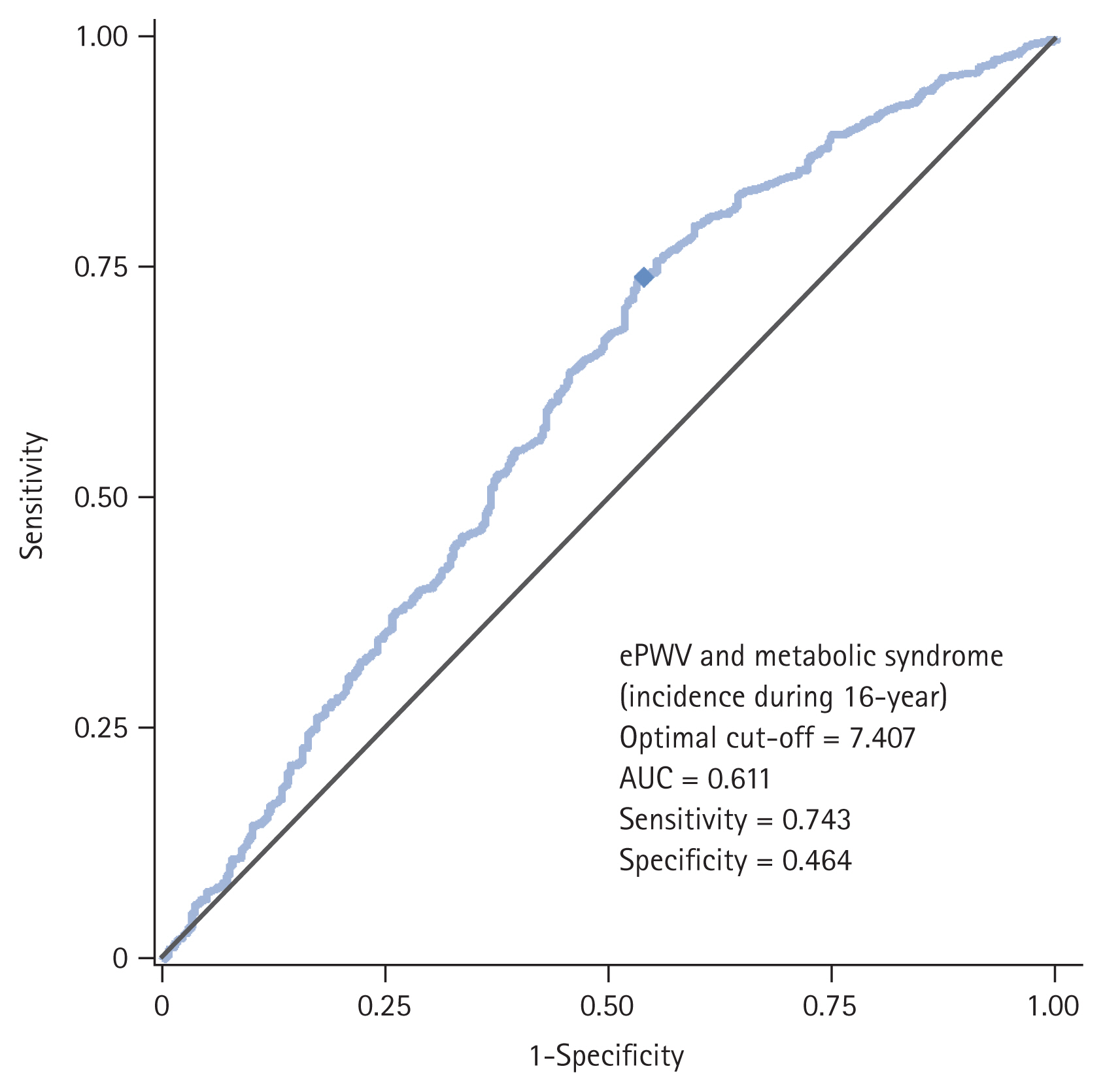
Time-dependent ROC curve analyses. ePWV, estimated pulse wave velocity; AUC, area under curve; ROC, receiver operating characteristic.
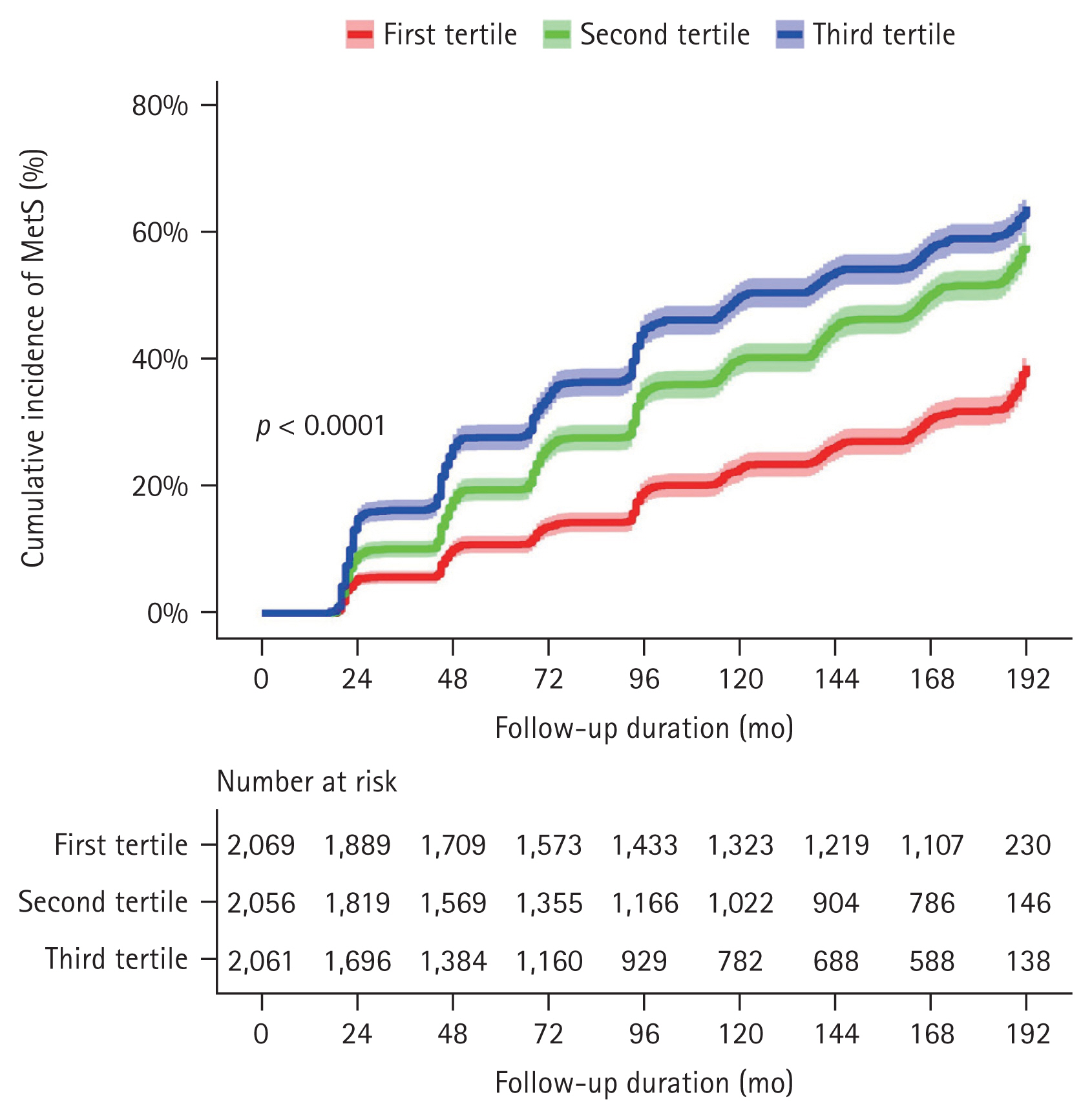
Kaplan–Meier curves comparing the cumulative incidence of metabolic syndrome according to tertiles of ePWV in participants. MetS, metabolic syndrome; ePWV, estimated pulse wave velocity.
Table 2 provides a quantitative assessment of the future risk of metabolic syndrome based on the ePWV categorization. Across all tertiles, ePWV values beyond the cut-off, especially in the second and third tertiles, had significant predictive power for the development of metabolic syndrome. These hazard ratios (HRs) remained robust even after adjusting for Models 1, 2, and 3. Participants exceeding the ePWV cut-off had a 1.425-fold increased independent risk of developing metabolic syndrome (HR, 1.425; 95% confidence interval [CI], 1.281–1.585). Furthermore, those in the third tertile showed an even higher risk, with an HR of 1.530 (95% CI, 1.330–1.761) compared to first tertile, even after adjusting for multiple variables.
We conducted a subgroup analysis stratified by various covariates including sex, income level, education level, and the presence of hypertension, diabetes mellitus, dyslipidemia, and chronic kidney disease. The association between ePWV and incidence of metabolic syndrome remained consistent across all subgroups. No significant interactions were observed in any of the subgroups (Fig. 4).
Cross-sectional association between ePWV and metabolic syndrome
In the concurrent evaluation, the cross-sectional relationship between the ePWV and metabolic syndrome was assessed. Supplementary Table 1 shows the baseline characteristics of the participants with available baseline data on metabolic syndrome (n = 9,722). Among these participants, the optimal cut-off value of ePWV for distinguishing participants with metabolic syndrome in a cross-sectional setting was 8.240 m/s (Supplementary Fig. 1). The ROC curve showed an AUC of 0.730, with a sensitivity of 0.789 and a specificity of 0.571. The association between ePWV and prevalence of metabolic syndrome is shown in Supplementary Table 2. Participants with an ePWV greater than the cut-off value of 8.240 m/s exhibited a notably higher prevalence of metabolic syndrome than those below this threshold. The gradient of association was evident when the population was categorized according to ePWV tertiles. This pattern remained consistent even after adjusting for potential confounders in various models, highlighting the importance of ePWV as an indicator of metabolic syndrome in the study population.
DISCUSSION
Among the Korean population aged 40–69 years who were previously unidentified as having metabolic syndrome, 44.1% of the 6,186 participants developed metabolic syndrome according to the modified NCEP ATP-III criteria over an average follow-up of 187 months. ePWV was strongly correlated with the risk of developing metabolic syndrome. Specifically, values with a cut-off of 7.407 m/s or higher independently increased the risk of metabolic syndrome compared to those below the cut-off value. Moreover, compared to the first tertile, the risk of metabolic syndrome was significantly heightened in the second tertile (7.36–8.76 m/s) and the third tertile (8.77–14.63 m/s). These findings remained significant, even after adjusting for possible confounding factors. Furthermore, groups with higher ePWV values correlated with an even greater increase in risk.
In Western China, the overall prevalence of metabolic syndrome ranged from 21.4% to 27.8% over an 8-year period [21]. In the United States, the prevalence of metabolic syndrome has shown a significant increase over time, with a reported prevalence of 25.3% in 1988–1994, which increased to 34.2% in 2007–2012 [22]. Comparatively, in the Asia-Pacific region, the prevalence of metabolic syndrome varies considerably [23]. In Korea, the current prevalence of metabolic syndrome among adults aged ≥ 19 years was 23%, and it was 45.3% among adults aged ≥ 65 years [24,25]. These comparisons revealed significant regional differences in metabolic syndrome prevalence, emphasizing the need for tailored public health strategies. In the present study, the prevalence rate of metabolic syndrome was 44.1% over a period of 15.6 years. This aligns with figures from other Asian contexts, but highlights the unique characteristics and health challenges of the Korean population.
While direct associations between ePWV and the future onset of metabolic syndrome have not been extensively documented, ePWV is a surrogate marker of arterial stiffness and a pivotal predictor of cardiovascular risk [12,26–31]. The European Society of Cardiology and the European Society of Hypertension have suggested that a carotid-femoral PWV value > 10 m/s signifies an increased cardiovascular risk [32]. However, these are general guidelines. The relevance and impact of specific cut-offs may vary based on demographics such as age, comorbidities, and ethnic background. Our study emphasizes the potential clinical importance of ePWV as an indicator, especially in populations in which direct measurements may not always be feasible. In real-world clinical settings, practitioners often encounter patients who are concerned about their prospective risk of metabolic disorders, despite lacking overt risk factors or symptoms. For such individuals, conventional risk assessment tools may not always provide the clearest insight given their inherent emphasis on manifest risk factors. ePWV, which can be conveniently determined, is a valuable supplementary metric in these scenarios, aiding in the anticipation of future metabolic risks. The distinct connection between ePWV and the components of metabolic syndrome [13–17], particularly in low-risk demographics, highlights the inherent pathophysiological association. Elevated ePWV potentially results from chronic subclinical challenges, such as minor inflammation, oxidative stress, and endothelial dysfunction [33–35], all of which play a role in the onset of metabolic syndrome [36,37].
The importance of our study lies in the demographics explored. The baseline characteristics of the participants suggested a relatively healthy adult population with a low prevalence of traditional cardiovascular risk factors. Indeed, only a small fraction had hypertension (5.4%), diabetes (0.7%), or dyslipidemia (0.4%). The “low-risk” nature of our cohort amplifies the clinical significance of our results. Studying a “low-risk” cohort to predict metabolic syndrome provides a unique set of insights that may be invaluable in real-world clinical contexts. This will assist clinicians in offering personalized risk assessments and interventions to those who seem to be at minimal risk at the surface level. Moreover, this paves the way for early preventive strategies to ensure that metabolic syndrome is diagnosed well before its onset, even in those who may not traditionally be considered vulnerable.
Our cross-sectional analysis offers a deeper understanding of the relationship between ePWV and metabolic syndrome. Although longitudinal associations provide insights into potential future risks, cross-sectional outcomes offer real-time health snapshots of the population. Arterial stiffness, as gauged by ePWV, is an indicator and a significant predictor of cardiovascular adversities [38,39]. The relationship between ePWV and cardiovascular disease has been well documented, suggesting its potential to indicate subclinical organ damage, especially in patients with metabolic syndrome [38]. Furthermore, metabolic syndrome has been linked to increased arterial stiffness, reinforcing the clinical utility of ePWV as a diagnostic tool [40]. Therefore, individuals presenting with augmented ePWV values indicative of increased arterial stiffness may be predisposed to metabolic syndrome [41]. This association indicated the potential for subclinical organ damage in these individuals. This is particularly significant in real-world clinical settings where practitioners often grapple with the challenge of identifying atrisk individuals who may not present with overt symptoms or classic risk factors.
In order to achieve a holistic understanding, it is essential to acknowledge the limitations of this study. This study focused on 6,186 individuals initially free from metabolic syndrome and intentionally selected a healthier subset to investigate the effects of ePWV on future metabolic syndrome development. Although this targeted approach limits generalizability to a broader Korean population, particularly to those with existing metabolic or cardiovascular conditions, it provides valuable insights into early markers and intervention points for metabolic syndrome in a relatively healthy cohort. Furthermore, the observation that in the third tertile of ePWV (8.77–14.63 m/s), metabolic syndrome developed in 52.8% of individuals, while 47.2% did not, highlights the multifactorial nature of the metabolic syndrome. This suggests that not all individuals with elevated ePWV develop metabolic syndrome, emphasizing the importance of considering factors beyond arterial stiffness in predicting the syndrome. Second, the nature of the ePWV calculation, which incorporates age and BP, presents a methodological challenge in our multivariate analysis. Adjusting for these variables, which are integral components of the ePWV formula, could have confounded our assessment of independent predictive value of ePWV for metabolic syndrome. Third, the observational nature of our study prevented us from establishing a causal association between the ePWV and metabolic syndrome. Fourth, the statistical concerns in this study arose from the simultaneous use of the same variables as predictors, outcomes, and confounders. This approach could lead to a circular reasoning scenario in which the factors contributing to arterial stiffness are also used to predict it. Such a methodological design may overstate the association between arterial stiffness and metabolic syndrome. Further research employing direct measurement methods, such as carotid-femoral PWV, is necessary to address this issue and validate our findings. However, exploring hard endpoints, such as cardiovascular mortality or other cardiovascular outcomes, could potentially strengthen the clinical relevance of our study. Assessing such outcomes could provide a more precise understanding of the implications of elevated ePWV in real-world clinical scenarios, particularly its role in cardiovascular health beyond the scope of metabolic syndrome.
Despite these limitations, the practicality of ePWV arises from its simplicity and accessibility. It can be easily measured using age and BP, which are two common and noninvasively obtained clinical parameters. This simplicity is particularly beneficial in settings where direct measurements of PWV are challenging owing to resource limitations, patient discomfort, or technical constraints. Estimating arterial stiffness using ePWV allows widespread screening and early detection of cardiovascular risks, even in primary care settings or resource-limited environments. Therefore, a comprehensive therapeutic approach is needed. Additionally, considering the subtle differences in arterial stiffness progression between sexes, future research should focus on sex-specific analyses. This approach will help understand how ePWV distinctly affects metabolic syndrome in men and women, leading to more tailored prevention and treatment strategies.
In conclusion, our study underscores the clinical utility of ePWV as a predictive marker of metabolic syndrome even in relatively healthy, low-risk Korean adults. This association warrants further investigation in diverse populations and settings to validate ePWV as a reliable tool in the preventive cardiology armamentarium.
KEY MESSAGE
1. Elevated ePWV is a strong predictor of future metabolic syndrome in a healthy, low-risk Korean adult population.
2. A cut-off value of 7.407 m/s for ePWV effectively identifies individuals at higher risk for developing metabolic syndrome, supporting its use in routine clinical practice.
3. Incorporating ePWV into early screening can aid in timely intervention and prevention of metabolic syndrome.
Acknowledgments
The authors thank the Korean Society of Cardiometabolic Syndrome for providing funding for this online survey.
Notes
CRedit authorship contributions
Hyun-Jin Kim: methodology, investigation, formal analysis, software, writing - original draft; Byung Sik Kim: methodology, investigation, data curation, formal analysis, writing - original draft; Dong Wook Kim: investigation, writing - review & editing; Jeong-Hun Shin: conceptualization, methodology, writing - review & editing, supervision
Conflicts of interest
The authors disclose no conflicts.
Funding
None


